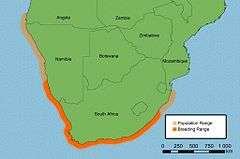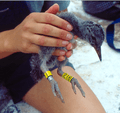African oystercatcher
| African oystercatcher | |
|---|---|
| | |
| African oystercatcher in Betty's Bay | |
| Scientific classification | |
| Kingdom: | Animalia |
| Phylum: | Chordata |
| Class: | Aves |
| Order: | Charadriiformes |
| Family: | Haematopodidae |
| Genus: | Haematopus |
| Species: | H. moquini |
| Binomial name | |
| Haematopus moquini (Bonaparte, 1856) | |
 | |
| African oystercatcher Population and Breeding Range. Orange = Breeding Range, Pale Orange = Population Range. | |
| Synonyms | |
|
Metanibyx africana ? | |
The African oystercatcher or African black oystercatcher (Haematopus moquini), is a large charismatic wader resident to the mainland coasts and offshore islands of southern Africa. This near-threatened oystercatcher has a population of over 6,000 adults, which breed between November and April.[9] The scientific name moquini commemorates the French naturalist Alfred Moquin-Tandon who discovered and named this species before Bonaparte.[10]
Description
The African oystercatcher is a large, noisy wader, with completely black plumage, red legs and a strong broad red bill. The sexes are similar in appearance, however, females are larger and have a slightly longer beak than males. Juveniles have soft grey plumage and do not express the characteristic red legs and beak until after they fledged. The call is a distinctive loud piping, very similar to Eurasian oystercatchers. As the Eurasian oystercatcher is a migratory species they only occur as a vagrant in southern Africa, and its black-and-white plumage makes confusion impossible.[9]
Average Measurements
Body Length: 42–45 cm (17–18 in)
Wingspan: 80 and 88 cm (31 and 35 in)
Mass: ♂ 665 g (1.466 lb) ♀ 730 g (1.61 lb)
Tarsus: 50.6 to 60.8 mm (1.99 to 2.39 in)
Culmen: 57.7 to 79.1 cm (22.7 to 31.1 in)[9]
Distribution and Habitat
The African oystercatcher is native to the mainland coasts and offshore islands of Southern Africa sometimes occurring as a vagrant in Angola and Mozambique. Its breeding range extends from Lüderitz, Namibia to Mazeppa Bay, Eastern Cape, South Africa. There are estimated to be over 6,000 adult birds in total.[1][9]
Typically sedentary African oystercatchers rarely leave their territories, which include a nesting site and feeding grounds. These will usually be located on or near rocky shores where they can feed.
Ecology
Feeding
African oystercatchers predominantly feed on molluscs such as mussels and limpets, although are known to also feed on polychaetes, insects[11] and potentially even fish.[12] They are adapted to pry open mussels and loosen limpets off the rocks but have been recorded picking through sand to locate other food items.
Breeding
The nest is a bare scrape on pebbles, sand or shingle within about 30 metres (98 ft) of the high-water mark. On rock ledges there may be a rim of shells to keep the eggs in place. The female generally lays two eggs, but there may be one or three, which are incubated by both adults. The incubation period varies between 27 and 39 days and the young take a further 38 or so days to fledge. Breeding success is greater on offshore islands where there are few predators and less disturbance than mainland sites.[13]
The eggs average about 65 mm (2.6 in) long, ranging from 45 to 73 mm (1.8 to 2.9 in), and have a breadth of 41 mm (1.6 in), ranging from 34 to 45 cm (13 to 18 in).
Longevity and mortality
The lifespan of an African oystercatcher is about 35 years, of which they are known to pair up for 25 years. Although adults are rarely predated most mainland egg and chick fatalities are due to disturbance by people, off-road vehicles, dog attacks and predation by the kelp gull (Larus dominicanus) and other avian preditors.[1] Off shore pairs experience similar avian predation although most chicks perish due to starvation.
Status
The IUCN lists the African oystercatcher as being "Near Threatened". The population trend seems to be upward as the local community becomes more involved in adopting conservation measures.[1]
Current Research
Ongoing research is being undertaken for this species on the migration of young. If you happen to see an oystercatcher with coloured or numbered bands on their legs take note of the numbers and colours and contact the ADU or Percy FitzPatrick Institute of African Ornithology with the information. If an adult is found dead with metal rings please let SAFRING know the details.
Gallery
-

Plettenberg Bay, South Africa
-
Feeding on the rocky shore
-
_standing_on_the_sand.jpg)
Taken in South Africa
-
_in_flight.jpg)
Three in flight
-

at De Hoop, South Africa
-

Three egg clutch
-

African oystercatcher chick
-

African oystercatcher shading eggs
-
A pair in flight
-
.jpg)
African oystercatcher 01
-

African oystercatcher
-

Haematopus moquini
-
Haematopus moquini
-

Haematopus moquini portrait
-

Haematopus moquini young
-
Haematopus moquini
References
- 1 2 3 4 BirdLife International (2012). "Haematopus moquini". IUCN Red List of Threatened Species. Version 2013.2. International Union for Conservation of Nature. Retrieved 26 November 2013.
- ↑ Parzudaki, Émile (1856). Catalogue des oiseaux d'Europe offerts, en 1856, aux ornithologistes. Paris: E. Parzudaki.
- ↑ Verzeichniss der Doubletten des zoologischer Museums hiesiger Königl.Universität...nebst Beschreibung vieler bisher unbekannter Arten von Säugethieren,Vögeln,Amphibien und Fischen...,p.73.
- ↑ The Genera of Birds, 1844-49, Pt.42, Haematopodinae (Dec.), no.2. bound vol.3,p. 547.
- ↑ Die vollständigste Naturgeschichte der Sumpfvögel:Aves Grallatores. (= Novitiae ad Synopsin Avium...II.Grallatories (III Rasores) No.: V, pl.168, figs.1042-43.
- ↑ Nomenclator avium Musei Zoologici Berolinensis.Namenverzeichniss,p.93. (Kaffernland). Not Haematopus unicolor Wagler,1832.
- ↑ Nomenclator Musei Heineani Ornithologici,p.337.
- ↑ Checklist of Birds of the World, 2, p.233.
- 1 2 3 4 Hockey, P. A. R. (2005). Roberts birds of southern Africa. Cape Town: Trustees of the John Voelcker Bird Book Fund.
- ↑ Parzudaki, Émile (1856). Catalogue des oiseaux d'Europe offerts, en 1856, aux ornithologistes. Paris: E. Parzudaki.
- ↑ Ryan, P. G.; Visagie, J. (2008). "African Black Oystercatchers feeding in a terrestrial habitat". Ostrich. 79: 243. doi:10.2989/ostrich.2008.79.2.18.592.
- ↑ Paijmans, D. M. (2013). "Piscivory in the African Black Oystercatcher". Promerops. 294: 15.
- ↑ "Species factsheet: African Oystercatcher Haematopus moquini". BirdLife International. Retrieved 2013-12-11.
External links
| Wikimedia Commons has media related to Haematopus moquini. |
- Species text in The Atlas of Southern African Birds.
- Birdlife Information site.
- Archive Information site.
- Two Oceans Aquarium Information site.
